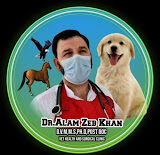Peste des Petits Ruminants (PPR), also known as goat plague or small ruminant plague, is a highly contagious viral disease that primarily affects goats and sheep. It causes severe economic losses in affected regions due to high mortality rates, reduced productivity, and trade restrictions. PPR is especially prevalent in Africa, Asia, and the Middle East. Awareness about its causes, clinical signs, and prevention is essential for farmers and veterinarians.
👉 Watch our detailed YouTube video on PPR for farmers:
PPR in Small Ruminants – Complete Guide
Etiology:
-
PPR is caused by the Peste des Petits Ruminants Virus (PPRV), a Morbillivirus of the Paramyxoviridae family.
-
It is closely related to viruses that cause rinderpest, measles, and canine distemper.
-
The disease mainly affects goats, with sheep showing milder signs.
Pathology:
-
PPRV enters through the respiratory or digestive tract and multiplies in lymphoid tissues.
-
It causes immunosuppression, damage to epithelial cells, and severe inflammation of the mouth, lungs, and intestines.
-
This leads to pneumonia, stomatitis (mouth ulcers), and enteritis (diarrhea).
Clinical Signs:
-
High fever (40–41°C) at onset.
-
Nasal and ocular discharge, which becomes thick and pus-like.
-
Erosions and ulcers in the mouth, leading to excessive salivation.
-
Foul-smelling diarrhea, often leading to dehydration.
-
Coughing and labored breathing due to pneumonia.
-
Weakness and emaciation in prolonged cases.
-
Death rate can be very high, especially in goats (up to 80-90% in severe outbreaks).
Diagnosis:
-
Based on history, clinical signs, and post-mortem lesions.
-
Laboratory confirmation by:
-
ELISA
-
RT-PCR
-
Virus isolation
-
Treatment:
-
No specific antiviral treatment exists for PPR.
-
Supportive care includes:
-
Fluids and electrolytes to combat dehydration.
-
Broad-spectrum antibiotics to prevent secondary bacterial infections.
-
Anti-inflammatory drugs for pain and fever.
-
Good nursing care: soft feed, clean water, shelter.
-
Prevention:
-
Vaccination is the most effective measure — annual vaccination of all susceptible animals.
-
Quarantine of new or sick animals to prevent spread.
-
Strict biosecurity on farms, including sanitation, disinfection, and controlled animal movement.
-
Public awareness and early reporting during outbreaks.
Conclusion:
PPR is a major threat to small ruminant health and farmers’ livelihoods. Timely vaccination, good farm hygiene, and rapid action during outbreaks are key to controlling this devastating disease. To better understand the signs, control measures, and field recommendations, we highly encourage farmers and animal health workers to watch our YouTube guide on PPR:
👉 PPR in Small Ruminants – Complete Guide
FAQs
1. Is PPR contagious to humans?
No, PPR does not affect humans. It is limited to small ruminants like goats and sheep.
2. Can PPR be cured?
There is no cure, but supportive care can reduce mortality. Vaccination prevents the disease.
3. How often should animals be vaccinated?
Ideally, vaccination should be done annually in endemic areas.
4. How is PPR spread?
Through direct contact with infected animals, their secretions, or contaminated materials.
5. Can recovered animals spread PPR?
Recovered animals usually do not act as carriers. The disease spreads mainly from acutely infected animals.


